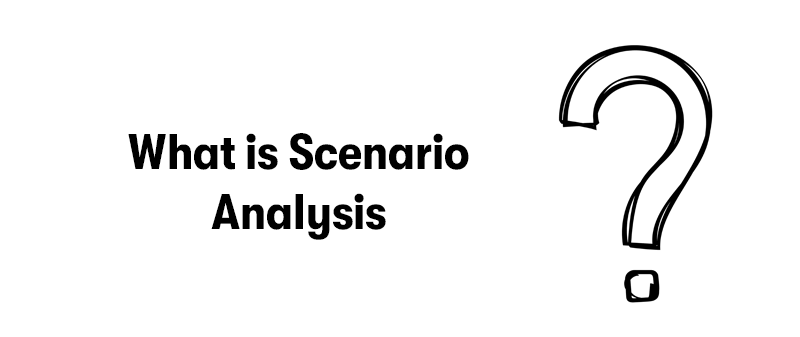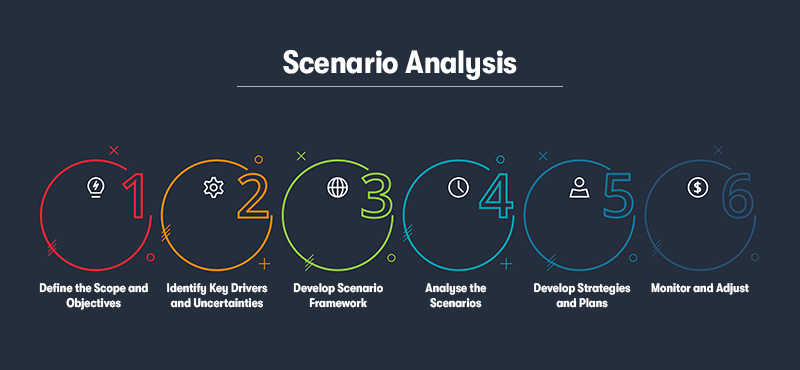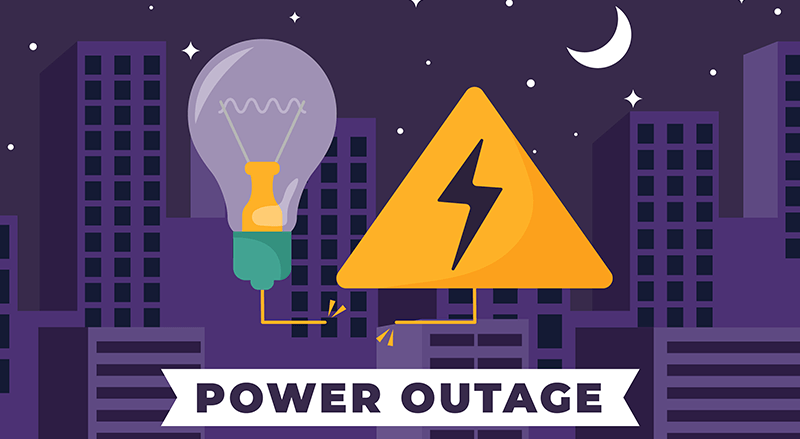Scenario analysis is a strategic planning method used to explore and evaluate possible future events by imagining and analysing various potential outcomes. It allows organisations to visualise the impact of different scenarios on their goals, aiding in decision-making under uncertainty.
The roots of scenario analysis can be traced back to the military strategies of the 1950s, notably developed by Herman Kahn at the RAND Corporation. It gained prominence in the corporate world in the 1970s, especially through its application by Royal Dutch Shell, which used it to navigate the oil crisis by preparing for multiple future scenarios.
This technique has since evolved into a fundamental tool across industries, helping businesses anticipate changes, manage risks, and seize opportunities in an unpredictable world.
What is Scenario Analysis

Scenario analysis is a process used to evaluate potential future events by considering alternative possible outcomes (scenarios). This method is widely used in strategic planning, where businesses or organisations assess the impact of different strategic decisions under various future scenarios. The aim is to understand how different factors, such as economic conditions, technological advances, or regulatory changes, might influence the organisation's objectives or the success of its strategies.
Scenario analysis helps organisations prepare for uncertainty by considering a wide range of possible futures. By understanding how different scenarios could impact their goals, they can make more informed decisions, develop flexible strategies, and better manage risk.
How to do Scenario Analysis

Scenario analysis, a strategic planning tool, helps organisations prepare for the future by examining how different situations could unfold and affect their objectives. It's particularly useful for making informed decisions in the face of uncertainty. Here's a step-by-step guide to conducting scenario analysis:
Step 1: Define the Scope and Objectives
Identify the Decision: Clearly define the decision or strategy you are evaluating.
Set the Objectives: Determine what you aim to achieve with this analysis, such as understanding potential risks or identifying opportunities.
Step 2: Identify Key Drivers and Uncertainties
Gather Information: Research the external and internal factors that could impact your decision. This includes market trends, technological changes, regulatory environments, and competitor behaviour.
Identify Key Drivers: From your research, pinpoint the critical factors that could significantly influence the outcome of your decision.
Determine Uncertainties: Highlight the uncertainties associated with these key drivers.
Step 3: Develop Scenario Framework
Select Scenarios: Based on the key drivers and uncertainties, develop a manageable number of scenarios. Typically, this includes a best-case, worst-case, and middle-ground scenario, but more can be added for depth.
Build Detailed Narratives: For each scenario, create a detailed narrative that describes how various factors interact and lead to the outcome. Ensure these narratives are plausible and internally consistent.
Step 4: Analyse the Scenarios
Assess Impacts: For each scenario, analyse how it would impact your objectives. Consider both quantitative measures (such as financial impact) and qualitative aspects (such as brand perception).
Identify Indicators: Determine which indicators might signal the unfolding of each scenario. These can help you monitor the environment and adjust your strategy accordingly.
Step 5: Develop Strategies and Plans
Formulate Strategies: Based on your analysis, develop strategies that can succeed across multiple scenarios or specific strategies to capitalise on opportunities and mitigate risks in individual scenarios.
Plan Actions: Identify the actions needed to implement these strategies, including contingency plans for different scenarios.
Step 6: Monitor and Adjust
Establish Monitoring Process: Set up a process to monitor the indicators identified earlier. This will help you track which, if any, of the scenarios is beginning to unfold.
Review and Adapt: Regularly review your strategies and plans in light of new information and changes in the external environment. Be prepared to adapt your approach as necessary.
Scenario Analysis Template
Here is a structured document that will guide you through the process of developing and analysing scenarios to inform strategic decisions:
Section 1: Overview
1.1 Objective
Description: Define the primary objective of conducting the scenario analysis.
Purpose: Explain why this scenario analysis is necessary.
1.2 Scope
Areas Covered: Specify the decision areas or strategies under review.
Time Horizon: Determine the time frame for the scenarios.
Section 2: Key Drivers and Uncertainties
2.1 Information Gathering
Sources: List the sources of information used (reports, market analysis, expert interviews, etc.).
Summary: Provide a brief overview of the key findings.
2.2 Key Drivers
List of Drivers: Enumerate the critical factors that could influence the outcomes (economic trends, technological advances, regulatory changes, etc.).
Analysis: Discuss how each driver impacts the objective.
2.3 Uncertainties
List of Uncertainties: Identify uncertainties related to each key driver.
Impact Analysis: Analyse the potential impact of these uncertainties.
Section 3: Scenario Development
3.1 Scenario Framework
Scenarios Identified: Describe the scenarios to be developed (e.g., best-case, worst-case, most likely case).
Rationale: Explain the reasoning behind the selection of each scenario.
3.2 Scenario Narratives
Scenario Descriptions: For each scenario, provide a detailed narrative, including how key drivers interact and the timeline of events.
Differences Highlighted: Clearly outline how each scenario differs from the others.
Section 4: Impact Analysis
4.1 Assessment Criteria
Criteria for Evaluation: List the metrics and criteria used to assess the impact on the objectives.
4.2 Scenario Impacts
Impact by Scenario: For each scenario, analyse the impacts, both quantitative and qualitative.
Comparison: Compare the impacts across different scenarios.
Section 5: Strategy Development
5.1 Strategic Options
General Strategies: Outline strategies that could be effective across multiple scenarios.
Scenario-specific Strategies: Develop strategies tailored to the opportunities and challenges of each specific scenario.
5.2 Action Plans
Implementation Steps: Detail the steps required to implement the strategies.
Contingency Plans: Describe plans for unexpected developments or scenario shifts.
Section 6: Monitoring and Review
6.1 Indicators
Key Indicators: List the indicators that will signal which scenario is unfolding.
Monitoring Process: Describe the process for monitoring these indicators.
6.2 Review Schedule
Review Frequency: Set how often the scenario analysis will be reviewed and updated.
Adjustment Mechanisms: Explain how strategies and plans will be adjusted based on new information or changes in the situation.
Section 7: Conclusion
Summary of Findings: Summarise the key insights gained from the scenario analysis.
Next Steps: Outline the immediate next steps to be taken following the completion of this analysis.
Download Scenario Analysis Template PDF
Download Scenario Analysis Template Word Document
This template serves as a comprehensive guide to conducting scenario analysis, ensuring a systematic approach to understanding potential future environments and making informed strategic decisions. Adjust the template as necessary to fit the specific needs and context of your organisation.
Scenario Analysis Example

The scenario analysis example is focused on the implementation of a new software tool within an organisation. The objective is to understand how different scenarios could impact the organisation's ability to improve service delivery and customer satisfaction.
Section 1: Overview
1.1 Objective
Description: Evaluate the potential impacts of implementing a new ITSM software tool on service delivery efficiency and customer satisfaction.
Purpose: To ensure that the organisation is prepared for various outcomes from the implementation and to develop strategies to maximise benefits and minimise risks.
1.2 Scope
Areas Covered: IT service desk operations, incident management, request fulfilment, and reporting capabilities.
Time Horizon: The first year following the software implementation.
Section 2: Key Drivers and Uncertainties
2.1 Information Gathering
Sources: Industry reports, software vendor information, customer feedback, and internal performance data.
Summary: The need for improved service delivery and customer satisfaction is evident, with potential software solutions offering varied capabilities.
2.2 Key Drivers
List of Drivers: User adoption rates, software integration capabilities, training effectiveness, and vendor support quality.
Analysis: These drivers are critical to the successful implementation and utilisation of the ITSM tool.
2.3 Uncertainties
List of Uncertainties: Rate of user adoption, integration complexity with existing systems, and the reliability of vendor support.
Impact Analysis: Uncertainties could lead to variations in implementation success, affecting service delivery and customer satisfaction.
Section 3: Scenario Development
3.1 Scenario Framework
Scenarios Identified: Optimistic Scenario, Pessimistic Scenario, Realistic Scenario.
Rationale: These scenarios encompass a range of possible outcomes based on the identified drivers and uncertainties.
3.2 Scenario Narratives
Optimistic Scenario: High user adoption, seamless software integration, effective training programs, and excellent vendor support lead to significant improvements in service delivery and customer satisfaction.
Pessimistic Scenario: Low user adoption, integration issues, inadequate training, and poor vendor support result in minimal improvements and potential disruptions.
Realistic Scenario: Moderate user adoption and some integration challenges are offset by effective training and good vendor support, leading to noticeable improvements in service delivery and customer satisfaction.
Section 4: Impact Analysis
4.1 Assessment Criteria
Criteria for Evaluation: Service delivery time, incident resolution rate, customer satisfaction scores, and return on investment (ROI).
4.2 Scenario Impacts
Optimistic Scenario Impact: Significant reduction in service delivery time, high incident resolution rate, improved customer satisfaction scores, and positive ROI.
Pessimistic Scenario Impact: Minimal reduction in service delivery time, unchanged or worsened incident resolution rate, stagnant customer satisfaction scores, and negative or low ROI.
Realistic Scenario Impact: Moderate reduction in service delivery time, improved incident resolution rate, higher customer satisfaction scores, and moderate ROI.
Section 5: Strategy Development
5.1 Strategic Options
General Strategies: Develop comprehensive training programs, establish a clear communication plan for software benefits, and ensure robust vendor support agreements.
Scenario-specific Strategies: For pessimistic scenarios, focus on enhancing user adoption through incentives and additional training, address integration challenges proactively, and establish a contingency plan for vendor issues.
5.2 Action Plans
Implementation Steps: Roll out the ITSM tool in phases, starting with a pilot program; gather feedback and adjust accordingly.
Contingency Plans: Prepare for integration issues by having technical support on standby and plan for additional training sessions if initial user adoption rates are low.
Section 6: Monitoring and Review
6.1 Indicators
Key Indicators: User adoption rates, service delivery times, customer satisfaction scores, and incident resolution rates.
Monitoring Process: Monthly review of performance metrics against predefined targets.
6.2 Review Schedule
Review Frequency: Quarterly review of the overall strategy and monthly performance monitoring.
Adjustment Mechanisms: Based on the reviews, adjust training, communication, and support strategies as needed to address any gaps.
Section 7: Conclusion
Summary of Findings: The scenario analysis highlights the importance of user adoption, software integration, training, and vendor support in the successful implementation of the ITSM tool.
Next Steps: Proceed with the phased implementation plan, focusing on the strategies identified to manage the key drivers and uncertainties effectively.
Sensitivity Analysis vs Scenario Analysis

Sensitivity Analysis and Scenario Analysis are both valuable tools used in strategic planning, risk management, and decision-making processes. Despite serving similar purposes in evaluating potential outcomes and impacts under different conditions, they are distinct in their approach, focus, and application. Understanding the differences between these two methods can help in selecting the most appropriate tool for a given analysis or decision-making process.
Sensitivity Analysis
Purpose: Sensitivity Analysis is used to understand how changes in one or more input variables affect the outcome of a model. It helps identify which variables have the most significant impact on the result, making it crucial for risk management and optimisation problems.
Approach: In Sensitivity Analysis, the analyst systematically changes one input variable at a time, keeping all other variables constant, to observe the effect on the outcome. This method can also be extended to test the effects of simultaneous changes in multiple variables, but the focus remains on understanding the relationship between individual input changes and the result.
Applications: It is widely used in financial modelling, engineering, and any scenario where it is crucial to identify which variables significantly influence the outcome. For example, a company might use Sensitivity Analysis to understand how changes in cost of raw materials or labour rates affect profitability.
Characteristics: Focuses on the impact of variable changes on a specific outcome. Often uses a range of values for each variable to test the effect on the model's outcome. Helps in identifying the most sensitive variables that need close monitoring.
Scenario Analysis
Purpose: Scenario Analysis is utilised to examine the outcomes of different future scenarios that result from various combinations of inputs or external conditions. It is instrumental in strategic planning, where the aim is to explore a range of possible futures and prepare for them.
Approach: In Scenario Analysis, the analyst develops several plausible scenarios based on different combinations of inputs or external conditions. Each scenario represents a distinct future state, considering multiple variables changing simultaneously in an integrated manner. The analysis assesses the impact of these scenarios on specific objectives or outcomes.
Applications: Scenario Analysis is commonly used for long-term strategic planning and risk management. For instance, businesses might use it to evaluate how different market conditions, regulatory environments, or technological advancements could affect their strategic goals.
Characteristics: Considers multiple variables changing simultaneously in a holistic manner. Develops comprehensive narratives for different future states. Helps organisations prepare for a wide range of possible futures.
Key Differences
Focus: Sensitivity Analysis focuses on the impact of changes in individual variables on an outcome, whereas Scenario Analysis explores the outcomes of different future scenarios that might arise from various combinations of changes.
Methodology: Sensitivity Analysis changes one variable at a time (ceteris paribus), analysing its impact on the result. Scenario Analysis considers multiple variables changing together to create distinct future scenarios.
Purpose: Sensitivity Analysis is primarily used for risk management and optimisation, identifying the most critical variables affecting an outcome. Scenario Analysis is used for strategic planning, helping prepare for multiple possible future conditions.
Complexity: Scenario Analysis typically involves more complex, integrated thinking about the future and multiple variables, requiring the development of narrative scenarios. Sensitivity Analysis is more straightforward, focusing on the quantitative impact of variable changes.
Both Sensitivity Analysis and Scenario Analysis provide valuable insights but serve different purposes. The choice between them depends on the specific objectives, the nature of the decision or strategy under consideration, and the complexity of the system being analysed.
Advantages and Disadvantages of Scenario Analysis
Scenario analysis is a bit like planning a journey, considering various routes and potential roadblocks along the way. This approach has several perks but also comes with a few caveats.
One of the big pluses is that it gets a business ready for unexpected twists and turns, making it easier to switch gears if needed. It's like having a backup plan for your backup plan, which can be really reassuring. It also makes decision-making a lot clearer because you've already thought about what might happen in different situations. Plus, it sparks creative thinking and new ideas by encouraging everyone to think outside the box and consider what the future might hold.
Another advantage is that it helps explain complicated plans to everyone involved, from employees to investors, in a way that's easy to understand. And, by identifying what could go wrong (or right), businesses can plan ahead to dodge problems or jump on opportunities.
However, scenario analysis isn't perfect. For starters, it can take up a lot of time and resources. Imagine trying to plan for every possible outcome of a trip—you could end up spending more time planning than actually travelling! It also involves a lot of guesswork since predicting the future is tricky. Despite best efforts, it's easy to miss something important simply because it's impossible to think of everything.
Then there's the issue of bias. Just like when planning a personal journey, people might lean towards scenarios they're more comfortable with or ignore potential pitfalls because they don't want them to happen. This could make the whole exercise less useful. And finally, there's a risk of getting so caught up in planning for every possible future that it becomes hard to make any decisions at all, which could stall progress.
In summary, while scenario analysis is a valuable tool for navigating the uncertainties of business, it's important to use it wisely. Balancing thorough planning with the flexibility to act is key to making the most of this approach.
Final Notes on Scenario Analysis
Scenario analysis equips organisations with the foresight to navigate future uncertainties, enabling strategic decision-making amidst volatility. By contemplating various potential outcomes—be it optimistic, pessimistic, or somewhere in between—it prepares entities to tackle unexpected changes, ensuring resilience and adaptability.
Despite its resource-intensive nature and the unpredictability of its predictions, the value of scenario analysis lies in its ability to foster a culture of preparedness and strategic thinking. The key to leveraging its full potential is maintaining flexibility in your strategies, ensuring your organisation can swiftly adapt as new information emerges and scenarios evolve.
One last tip - The true power of scenario analysis lies not in the accuracy of each scenario but in the agility it gives your organisation to adapt to change. Regularly update your scenarios as new information comes to light, and always be ready to pivot your strategy. This ongoing process ensures your organisation remains resilient, responsive, and ready for whatever the future holds.



